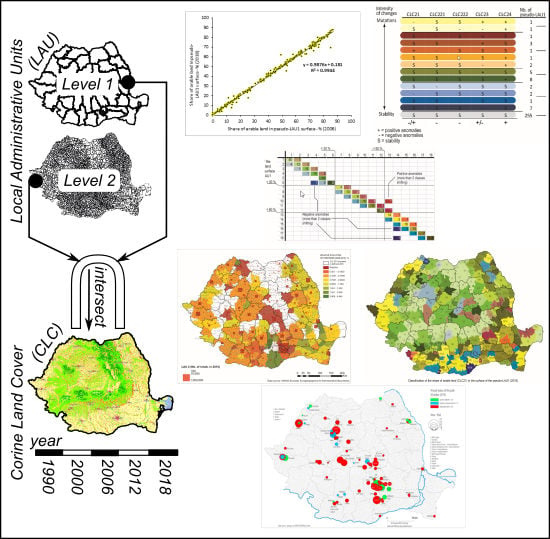Structural Changes in the Romanian Economy Reflected through Corine Land Cover Datasets
Abstract
1. Introduction
2. Materials and Methods
2.1. The Main Economic Changes and Land-Use Transformation in Romania after the Collapse of Communism
2.2. Datasets and Methods
- (1)
- The building blocks of an alternative geometry that fills the gaps between the local and the regional level of analysis and data integration are the Romanian LAU2, defined and generalized by the EUROSTAT geometry, via GISCO.
- (2)
- The pseudo-LAU1 frame that needs to be created will be spatially limited by the NUTS3 boundaries. This means that two neighbors LAU2 placed in different NUTS3 will not be aggregated in a pseudo-LAU1.
- (3)
- Generate a contiguity lattice between all the LAU2 centroids that respects the NUTS3 territorial belonging constraint. Populate the links between any pair of neighbor LAU2 with an impedance indicator. This impedance is the geo-statistical filter that will allow the aggregation of LAU2 in pseudo-LAU1 spatial units. In order to obtain heterogeneous new spatial units, we have made an option for an impedance indicator based on a potential accessibility function to population [33]. The equation of the accessibility function weights the demographic masses of all the Romanian LAU2 with the inverse Euclidean distance that separates them.where: Pi = potential accessibility function for each Romanian LAU2 i; Mi = population of each Romanian LAU2 in 2015, according to the NSI estimation; Mj = population of each Romanian LAU2 j that potentially interacts with i, in the frame of each NUTS3; Dij = the Euclidean distance that separates i and j.Once the potential accessibility function was created and transformed in an impedance function, the contiguity lattice was used as a network that connects all the Romanian LAU2. The network dataset can now be used for implementing p-median analysis (location-allocation models), in order to delineate the pseudo-LAU1 geometry. All the Romanian LAU2 were retained in the analysis, both as candidates for an eventual spatial aggregation and demand points in the model. The potential accessibility function acts like a similarity measure between the features [34]. When the values of the indicator are high, the pairs of LAU2 i and j are aggregated in a new polygon labeled pseudo-LAU1. If the values are low, an alternative solution is found and the LAU2 are directed to another candidate center. Our first option for a potential accessibility function was the result of a basic intention, to avoid the creation of pseudo-LAU1 that is potentially homogeneous from the point of view of the land use. This solution maximizes the chances that the pseudo-LAU1 frame will intersect different CLC layers (artificial, agriculture, natural land cover or water bodies).
- (4)
- The total number of pseudo-LAU1 to be created is a function of an objective criterion. Different tests were applied and the optimal solution was fixed at 290 spatial units. Tests with more than 290 pseudo-LAU1 objects often create unique polygons that aggregate only one or two LAU2. When the value is lower than 290, the model emphasizes the role played by the large cities in the demographic system, making unequal size objects. This stable layer of alternative geometry is the frame that will be used in order to detect anomalies in the evolution of CLC categories (Figure 1).
- (5)
- The stable version of the pseudo-LAU1 geometry was intersected with the CLC 2006 and CLC 2018 seamless vector layer datasets. For each CLC category, a summarizing operation was implemented, so that the pseudo-LAU1 objects can be used to assess changes in time. The land-use/cover surfaces integrated in the alternative geometry were recalculated and expressed in km2. This new database offered us the opportunity to check for relevant changes in the land-use patterns, changes that are dependent on the mathematical formalization of the dynamics [35]. Even if some of the dynamics might look spectacular in relative terms (% growth for a CLC category), they are irrelevant as an absolute difference. Moreover, these changes become even more questionable when reported to the area of the pseudo-LAU1 where we focused our analysis. The absolute change is limited at the scale of the pseudo-LAU1 (0.35 km2 in the first case, 0.17 km2 in the second case). In relative terms and having vineyards (CLC 221-2006) as a basis, the dynamics look consistent (8% and 60%).
- (6)
- The recent progress in the use of the transition probability matrix for assessing economic convergence phenomena [36] at different scales suggests that, when dealing with time-dependent anomalies of evolution, using this transition matrix approach is a sound way to investigate trends. As the land-use dynamics are not convergent on a steady state, implementing more sophisticated analysis, such as half-life indicators of the CLC categories, is not recommended because the possible Markov chains will not necessarily act in an ergodic state [37]. This is the reason why, in order to encompass as much as possible of the land-use dynamics, the CLC categories aggregated at pseudo-LAU1 scale were classified, for t0 = 2006 and t1 = 2018. The classification approach was different for each CLC category, as the data distributions are different and the transition matrix functions only with classes that are similar in time.
3. Results
3.1. From Data Management to Map Output Analysis–Major Trends Affecting Land Use in Romania
3.2. Case Study–Arable Land Transformations (CLC21)
3.3. Case Study–Vineyard Transformations (CLC221)
3.4. Case Study–Wet Areas (CLC4)
4. Discussion
5. Conclusions
Author Contributions
Funding
Acknowledgments
Conflicts of Interest
Appendix A
References
- Lambin, E.F.; Geist, H.J. Land use and land cover change. In Local Processes and Global Impacts; Springer: Berlin, Germany, 2006; Volume xviii, p. 222. [Google Scholar]
- Feranec, J.; Soukup, T.; Taff, G.N.; Stych, P.; Bicik, I. Overview of changes in land use and land cover in Eastern Europe. In Land-cover and land-use changes in Eastern Europe after the collapse of the Soviet Union in 1991; Gutman, G., Radeloff, V., Eds.; Springer: Basel, Switzerland, 2017; Volume VIII, pp. 13–33. [Google Scholar]
- Popovici, E.A.; Bălteanu, D.; Kucsicsa, G. Assessment of changes in land-use and land-cover pattern in Romania using Corine land cover database. Carpath. J. Earth Environ. Sci. 2013, 8, 195–208. [Google Scholar]
- Hanganu, J.; Constantinescu, A. Land cover changes in Romania based on Corine Land Cover inventory 1990–2012. Rev. Roum. Géogr. Rom. Journ. Geogr. 2015, 59, 111–116. [Google Scholar]
- Kucsicsa, G.; Popovici, E.; Bălteanu, D.; Grigorescu, I.; Dumitrascu, M.; Mitrica, B. Future land use/cover changes in Romania: Regional simulations based on CLUE-S model and CORINE land cover database. Landscape Ecol. Eng. 2019, 15, 75–90. [Google Scholar] [CrossRef]
- EU-LUPA—European Land Use Patterns, ESPON Applied Research, Final Report Part B, 2014. Available online: https://www.espon.eu/sites/default/files/attachments/DFR_Scientific_Report_EU-LUPA.pdf (accessed on 2 February 2020).
- Feranec, J.; Jaffrain, G.; Soukup, T.; Hazeu, G. Determining changes and flows in European landscapes 1990–2000 using CORINE land cover data. Appl. Geogr. 2010, 30, 19–35. [Google Scholar] [CrossRef]
- Meneses, B.M.; Pereira, S.; Reis, E. Effects of different land use and land cover data on the landslide susceptibility zonation of road networks. Nat. Hazards Earth Syst. Sci. 2019, 19, 471–487. [Google Scholar] [CrossRef]
- Vilar, L.; Garrido, J.; Echavarría, P.; Martínez-Vega, J.; Martín, M.P. Comparative analysis of CORINE and climate change initiative land cover maps in Europe: Implications for wildfire occurrence estimation at regional and local scales. Inter. J. Appl. Earth Obser. Geoinf. 2019, 78, 102–117. [Google Scholar] [CrossRef]
- Ursu, A.; Andrei, M.; Chelaru, D.A.; Ichim, P. Built-up area change analysis in Iasi city using GIS. Pres. Environ. Sustain. Dev. 2016, 10, 201–216. [Google Scholar] [CrossRef][Green Version]
- Tomasciuc, A.I.; Ursu, A.; Hapciuc, O.E.; Iatu, C. The influence of natural factors on land-use changes in the metropolitan area of Suceava, Romania (1980–2012). In Proceedings of the 16th International Multidisciplinary Scientific GeoConference: SGEM: Surveying Geology & mining Ecology Management, Albena, Bulgaria, 30 June–6 July 2016. [Google Scholar]
- Petrişor, A.I.; Petrişor, L.E. Transitional dynamics based trend analysis of land cover and use changes in Romania during 1990–2012. Pres. Environ. Sustain. Dev. 2018, 12, 215–231. [Google Scholar]
- Leśniewska-Napierała, K.; Nalej, M.; Napierała, T. The Impact of EU Grants Absorption on Land Cover Changes—The Case of Poland. Remote Sens. 2019, 11, 2359. [Google Scholar] [CrossRef]
- Bielecka, E.; Jenerowicz, A. Intellectual Structure of CORINE Land Cover Research Applications in Web of Science: A Europe-Wide Review. Remote Sens. 2019, 11, 2017. [Google Scholar] [CrossRef]
- Ustaoglu, E.; Aydınoglu, A.C. Regional Variations of Land-Use Development and Land-Use/Cover Change Dynamics: A Case Study of Turkey. Remote Sens. 2019, 11, 885. [Google Scholar] [CrossRef]
- Jonard, F.; Lambotte, M.; Ramos, F.; Terres, J.M.; Bamps, C. Delimitations of rural areas in Europe using criteria of population density, remoteness and land cover. JRC Scientific and Technical Reports, EU Comission, IES. 2009. Available online: https://ec.europa.eu/jrc/en/publication/eur-scientific-and-technical-research-reports/delimitations-rural-areas-europe-using-criteria-population-density-remoteness-and-land-cover (accessed on 5 April 2020).
- Sakamoto, H.; Islam, N. Convergence across Chinese provinces: An analysis using Markov transition matrix. China Econ. Rev. 2008, 19, 66–79. [Google Scholar] [CrossRef]
- Lai, S.; Leone, F.; Zoppi, C. Land cover changes and environmental protection: A study based on transition matrices concerning Sardinia (Italy). Land Use Policy 2017, 67, 126–150. [Google Scholar] [CrossRef]
- Law no. 18 from 19 February 1991 - Law of the land fund (in Romanian). Available online: http://www.cdep.ro/pls/legis/legis_pck.htp_act_text?idt=1622 (accessed on 23 February 2020).
- Law no. 7 from 13 March 1996 - Law on cadaster and real estate advertising (in Romanian). Available online: http://www.ancpi.ro/files/Documente/Lege_7_2019.pdf (accessed on 23 February 2020).
- Law no. 54 from 2 March 1998 - Law regarding the legal circulation of land (in Romanian). Available online: http://legislatie.just.ro/Public/DetaliiDocumentAfis/14220 (accessed on 23 February 2020).
- National Bank of Romania. Foreign Direct Investments in Romania in 2018. Available online: https://www.bnr.ro/PublicationDocuments.aspx?icid=9403. (accessed on 23 February 2020).
- Law no. 1 of January 11, 2000 for the reconstitution of the property right on agricultural and forest lands, requested according to the provisions of the Law of the land fund no. 18/1991 and of Law no. 169/1997. Available online: http://legislatie.just.ro/Public/DetaliiDocument/20557 (accessed on 23 February 2020).
- Bell, D. Previewing Planet Earth in 2013. The Washington Post, 3 January 1988; B3. [Google Scholar]
- Law no. 190 of October 25, 2019 to amend Law no. 351/2001 regarding the approval of the National Territory Planning Plan - Section IV - Localities Network. Available online: http://legislatie.just.ro/Public/DetaliiDocumentAfis/219146 (accessed on 24 February 2020).
- Law no. 17 of March 7, 2014 regarding some measures to regulate the sale-purchase of agricultural lands located in the outskirts and amending the Law no. 268/2001 regarding the privatization of the commercial companies that hold in public lands public and private property of the state with agricultural destination and the establishment of the State Domains Agency. Available online: https://www.madr.ro/terenuri-agricole/legislatie/1-lege-nr-17-din-7-martie-2014.html (accessed on 24 February 2020).
- The Atlas of Romania. Available online: http://www.mdlpl.ro/_documente/atlas/atlas.htm (accessed on 5 April 2020).
- Lohrberg, F.; Wirth, T.; Brüll, A.; Nielsen, M.; Coppens, A.; Godart, M.F.; Kempenaar, A.; Brinkhuijsen, M.; Morris, F. LP3LP Landscape Policy for the Three Countries Park - Final Report / Main Report. 2014. Available online: https://www.espon.eu/sites/default/files/attachments/LP3LP_Inception-Report_incl_Annex.pdf (accessed on 24 January 2020).
- Cegielskaa, K.; Noszczyka, T.; Kukulskaa, A.; Szylara, M.; Hernika, J.; Dixon-Gougha, R.; Jombachb, S.; Valánszkib, I.; Kovácsb, K.F. Land use and land cover changes in post-socialist countries: Some observations from Hungary and Poland. Land Use Policy 2018, 78, 1–18. [Google Scholar] [CrossRef]
- Feranec, J.; Hazeu, G.; Christensen, S.; Jaffrain, G. Corine land cover change detection in Europe (case studies of the Netherlands and Slovakia). Land Use Policy 2007, 24, 234–247. [Google Scholar] [CrossRef]
- García-Álvarez, D.; Camacho Olmedo, M.T. Changes in the methodology used in the production of the Spanish CORINE: Uncertainty analysis of the new maps. Int. J. Appl. Earth Observ. Geoinf. 2017, 63, 55–67. [Google Scholar]
- Montfort, P. Convergence of EU regions. Measures and evolution, Working papers. A series of short papers on regional research and indicators produced by the Directorate-General for Regional Policy. No. 1/2008. Available online: https://ec.europa.eu/regional_policy/sources/docgener/work/200801_convergence.pdf (accessed on 20 January 2020).
- Suau-Sanchez, P.; Burghouwt, G.; Pallares-Barbera, M. An appraisal of the CORINE land cover database in airport catchment area analysis using a GIS approach. J. Air Trans. Manag. 2014, 34, 12–16. [Google Scholar] [CrossRef]
- Castillo, C.P.; Aliaga, E.C.; Lavalle, C.; Llario, J.C.M. An Assessment and Spatial Modelling of Agricultural Land Abandonment in Spain (2015–2030). Sustainability 2020, 12, 560. [Google Scholar] [CrossRef]
- Pekkarinen, A.; Reithmaier, L.; Strobl, P. Pan-European forest/non-forest mapping with Landsat ETM+ and CORINE Land Cover 2000 data. ISPRS J. Photogrammetry Remote Sens. 2009, 64, 171–183. [Google Scholar] [CrossRef]
- Almeida, M.; Loupa-Ramos, I.; Menezes, H.; Carvalho-Ribeiro, S.; Pinto-Correia, T. Urban population looking for rural landscapes: Different appreciation patterns identified in Southern Europe. Land Use Policy 2016, 53, 44–55. [Google Scholar] [CrossRef]
- Hasegawa, S.F.; Takada, T. Probability of Deriving a Yearly Transition Probability Matrix for Land-Use Dynamics. Sustainability 2019, 11, 6355. [Google Scholar] [CrossRef]
- Aldwaik, S.Z.; Pontius, R.G., Jr. Intensity analysis to unify measurements of size and stationary of land changes by interval, category and transition. Landsc. Urban Plan. 2012, 106, 103–114. [Google Scholar] [CrossRef]
- National Agency for Land Improvement Agency. National rehabilitation program of the irrigation network. 2020. Available online: www.anif.ro (accessed on 5 April 2020).
- Ministry of Agriculture and rural development. General Report on Romanian agriculture. 2019. Available online: www.madr.ro (accessed on 5 April 2020).
- National Institute of Statistics, Press release no. 149/2 July 2012, Definitive results on RGA 2010. Available online: https://insse.ro/cms (accessed on 5 April 2020).
- Anghelache, C. Structural analysis of Romanian agriculture, Romanian Statistical Review - Supplement, 2/2018. Available online: http://www.revistadestatistica.ro/supliment/wpcontent/uploads/2018/02/RRSS_02_2018_A1_RO.pdf (accessed on 5 April 2020).
- Prăvălie, R.; Sîrodoev, I.; Patriche, C.; Roșca, B.; Piticar, A.; Bandoc, G.; Sfîcă, L.; Tișcovschi, A.; Dumitrașcu, M.; Chifiriuc, C.; et al. The impact of climate change on agricultural productivity in Romania. A country-scale assessment based on the relationship between climatic water balance and maize yields in recent decades. Agric. Syst. 2020, 179. [Google Scholar] [CrossRef]
- Irimia, L.; Patriche, C.V.; Quenol, H.; Sfîcă, L.; Foss, C. Shifts in climate suitability for wine production as a result of climate change in a temperate climate wine region of Romania. Theor. App. Climat. 2017, 131, 1069–1081. [Google Scholar] [CrossRef]
- Irimia, L.M.; Patriche, C.V.; LeRoux, R.; Quénol, H.; Tissot, C.; Sfîcă, L. Projections of climate suitability for wine production for the Cotnari wine region (Romania). Pres. Environ. Sustain. Dev. 2019, 13, 5–18. [Google Scholar]
- Moriondo, M.; Jones, G.V.; Bois, B.; Dibari, C.; Ferrise, R.; Trombi, G.; Bindi, M. Projected shifts of wine regions in response to climate change. Clim. Change 2013, 119, 825–839. [Google Scholar] [CrossRef]
- Romanescu, A.M.; Romanescu, G. Anthropic changes in the area of the Stânca-Costești lake. Case study on hydrological risk; Terra Nostra Press: Iași, Romania, 2015. (in Romanian) [Google Scholar]
- Minea, I. The Vulnerability of Water Resources from Eastern Romania to Anthropic Impact and Climate Change. In Water Resources Management in Romania; Negm, A., Romanescu, G., Zeleňáková, M., Eds.; Springer: Cham, Germany, 2020; pp. 229–250. [Google Scholar] [CrossRef]
- Romanescu, G.; Stoleriu, C.C. Exceptional floods in the Prut basin, Romania, in the context of heavy rains in the summer of 2010. Nat. Hazards Earth Syst. Sci. 2017, 17, 381–396. [Google Scholar] [CrossRef]
- Romanescu, G.; Cîmpeanu, C.I.; Mihu-Pintilie, A.; Stoleriu, C.C. Historic flood events in NE Romania (post-1990). J. Maps 2017, 13, 787–798. [Google Scholar] [CrossRef]
- Banuc, G.; Minea, I.; Dicu, I. Historical floods on the lower Danube and their consequences on urban areas. Case study Galați city (Romania), International Multidisciplinary Scientific Geoconferences, SGEM 2016. In Proceedings of the 16th GeoConference on Water resources, Forest, Marine and Ocean Ecosystems, Albena, Bulgaria, 30 June–6 July 2016; Volume 1, pp. 399–406. [Google Scholar] [CrossRef]
- Romanescu, G.; Mihu-Pintilie, A.; Stoleriu, C.C.; Carboni, D.; Paveluc, L.E.; Cîmpanu, C.I. A Comparative Analysis of Exceptional Flood Events in the Context of Heavy Rains in the Summer of 2010: Siret Basin (NE Romania) Case Study. Water 2018, 10, 216. [Google Scholar] [CrossRef]
- Minea, I.; Sfîcă, L. Assesment of hydrological drought in the north-eastern part of Romania. Case study – Bahlui catchment area, Proceedings of Air and Water Components of the Environment Conference. Aerulşiapacomponente ale mediului 2017, 93–100. [Google Scholar]
- Birsan, M.V.; Zaharia, L.; Chendes, V.; Branescu, E. Seasonal trends in Romanian streamflow. Hydrol. Proc. 2014, 28, 4496–4505. [Google Scholar] [CrossRef]
- Croitoru, A.E.; Minea, I. The impact of climate changes on rivers discharge in Eastern Romania. Theor. Appl. Climatol. 2015, 20, 563–573. [Google Scholar] [CrossRef]
- Croitoru, A.E.; Piticar, A.; Sfîcă, L.; Harpa, G.V.; Rosca, C.F.; Tudose, T.; Horvath, C.; Minea, I.; Ciupertea, F.A.; Scripca, A.S. Extreme Temperature and precipitation Events in Romania; Romanian Academy Press: Bucharest, Romanian, November 2018. [Google Scholar]
- Wu, H.; Li, Z.L. Scale Issues in Remote Sensing: A Review on Analysis, Processing Modeling. Sensors 2009, 9, 1768–1793. [Google Scholar] [CrossRef] [PubMed]
- Nol, L.; Verburg, P.H.; Heuvelink, G.B.M.; Molenaar, K. Effect of land cover data on nitrous oxide inventory in fen meadows. J. Environ. Qual. 2008, 37, 1209–1219. [Google Scholar] [CrossRef] [PubMed]
- Blanchard, S.D.; Pontius, R.G., Jr.; Urban, K.M. Implications of Using 2 m versus 30 m Spatial Resolution Data for Suburban Residential Land Change Modeling. J. Environ. Inf. 2015, 25, 1–13. [Google Scholar]
- Álvarez, D.G.; Camacho Olmedo, M.T.; Paegelow, M. Sensitivity of a common Land Use Cover Change (LUCC) model to the scale (Minimum Mapping Unit and Minimum Mapping Width) of input vector maps. Computers Environ. Urban Syst. 2019, 78, 101389. [Google Scholar] [CrossRef]
- Feranec, J.; Soukup, T.; Hazeu, G.; Jaffrain, G. Chapter 7. CORINE Land Cover Products. In European Landscape Dynamics: CORINE land cover data; CRC Press: Boca Raton, FL, USA, 19 August 2016; pp. 275–304. [Google Scholar]
- Martínez-Fernández, J.; Ruiz-Benito, P.; Bonet, A.; Gomez, C. Methodological variations in the production of CORINE Land Cover and consequences for long-term land cover change studies. The case of Spain. Int. J. Remote Sens. 2019, 40, 8914–8932. [Google Scholar] [CrossRef]
- Grigorescu, I.; Kucsicsa, G.; Popovici, E.; Mitrică, B.; Dumitrașcu, M.; Mocanu, I. Regional disparities in the urban sprawl phenomenon in Romania using CORINE land cover database. Rom J. Geogr. 2018, 62, 169–184. [Google Scholar]
- Cihlar, J.; Jansen, L. From Land Cover to Land Use: A Methodology for Efficient Land Use Mapping over Large Areas. Prof. Geographer 2001, 53, 275–289. [Google Scholar] [CrossRef]
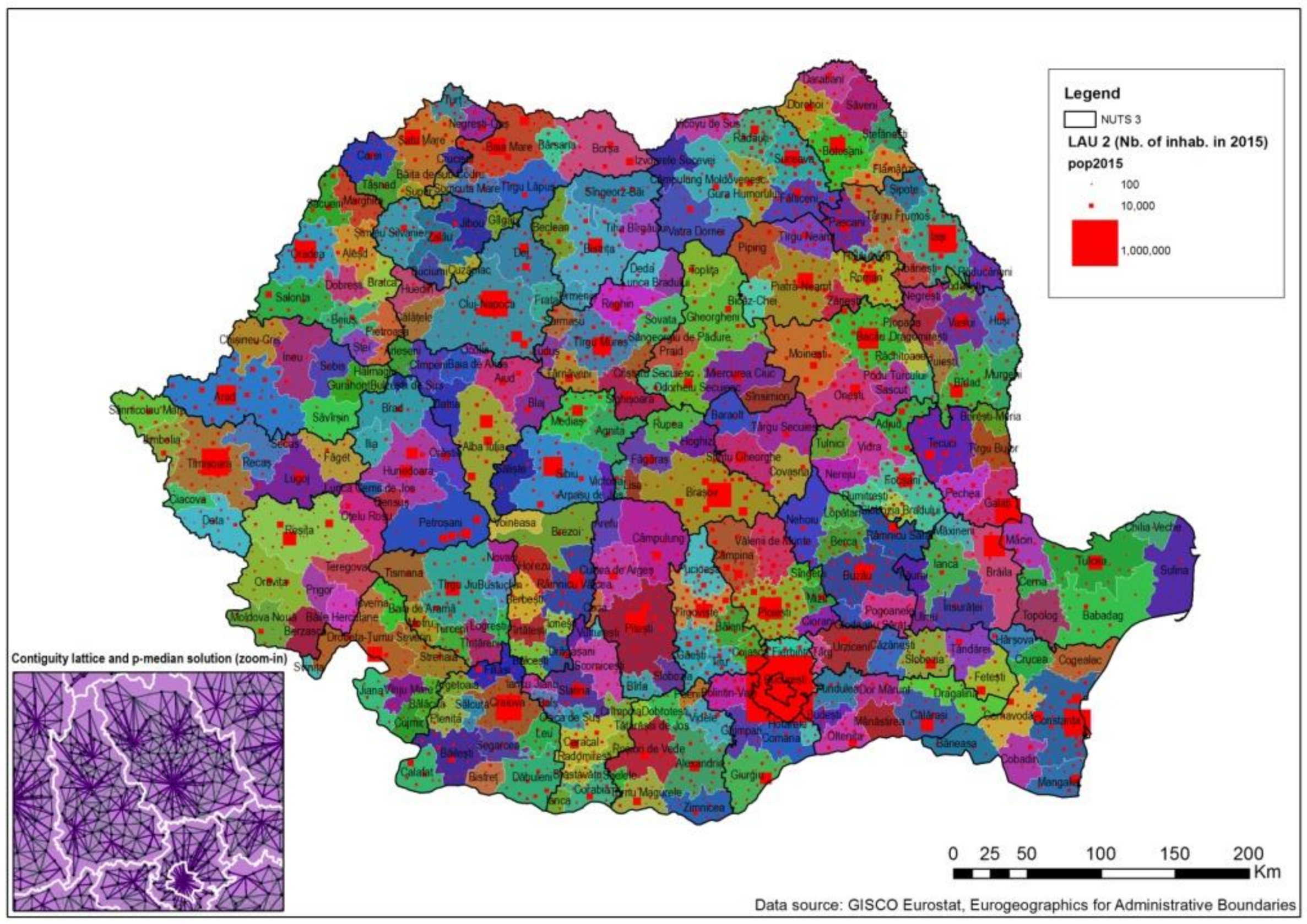
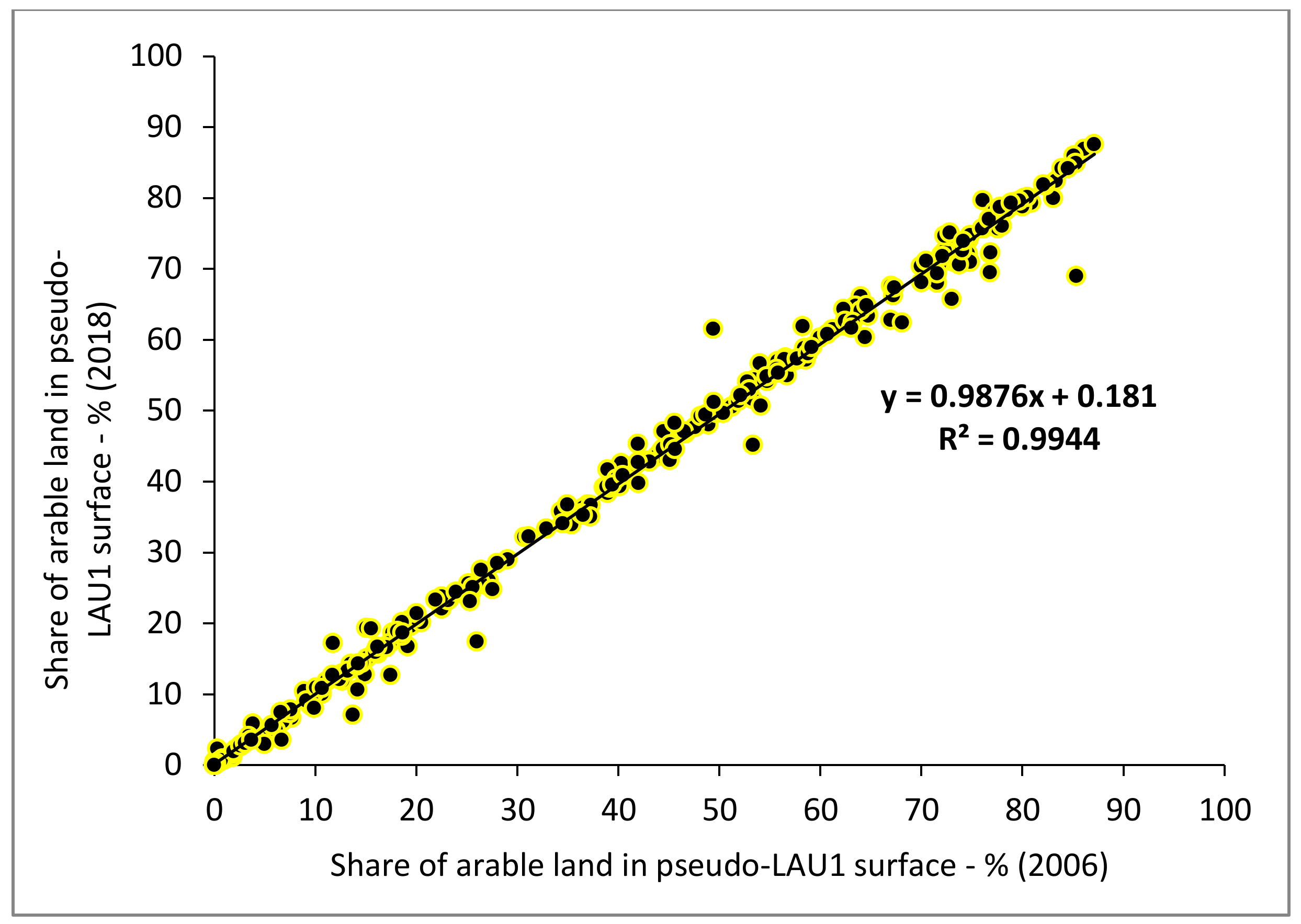

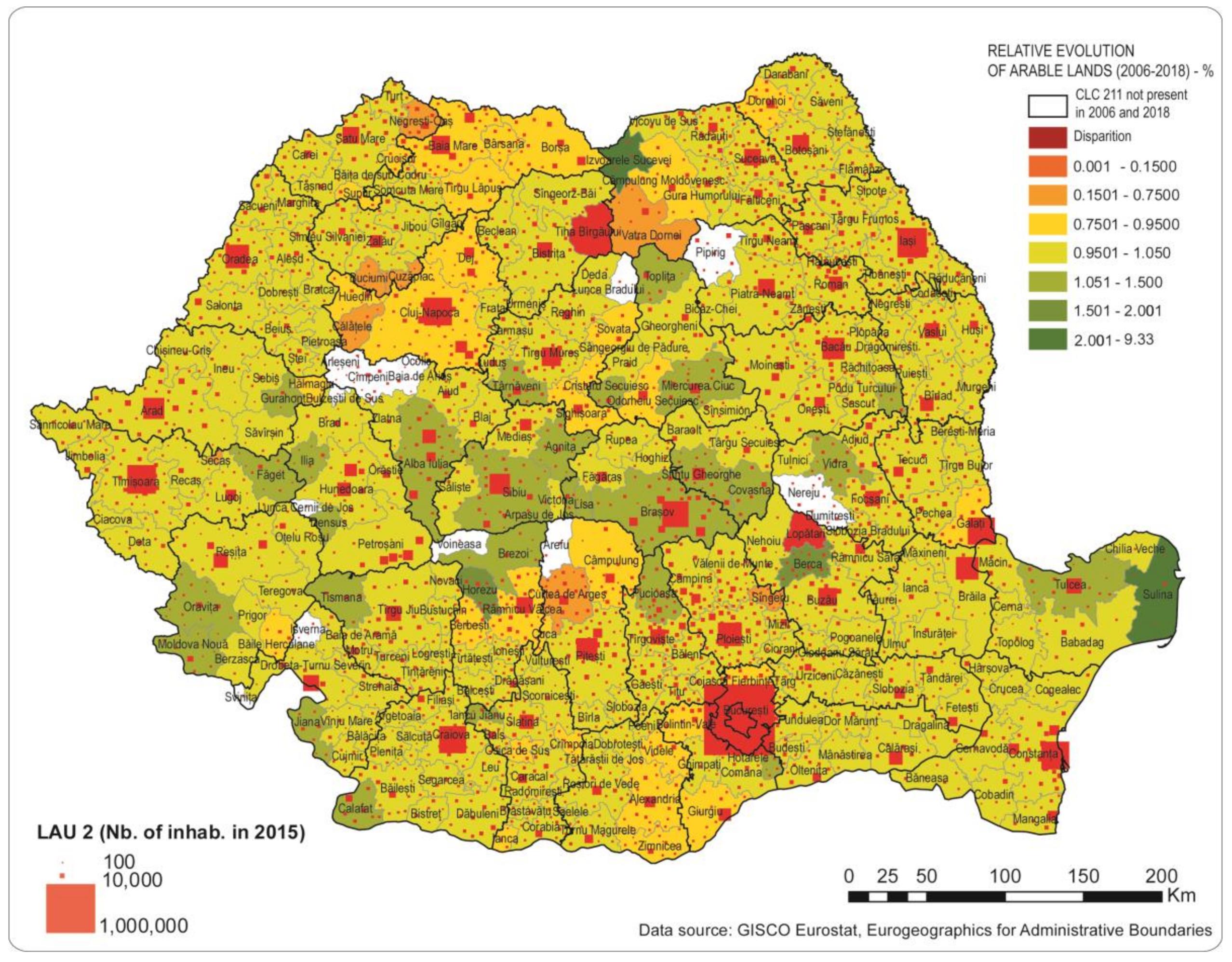

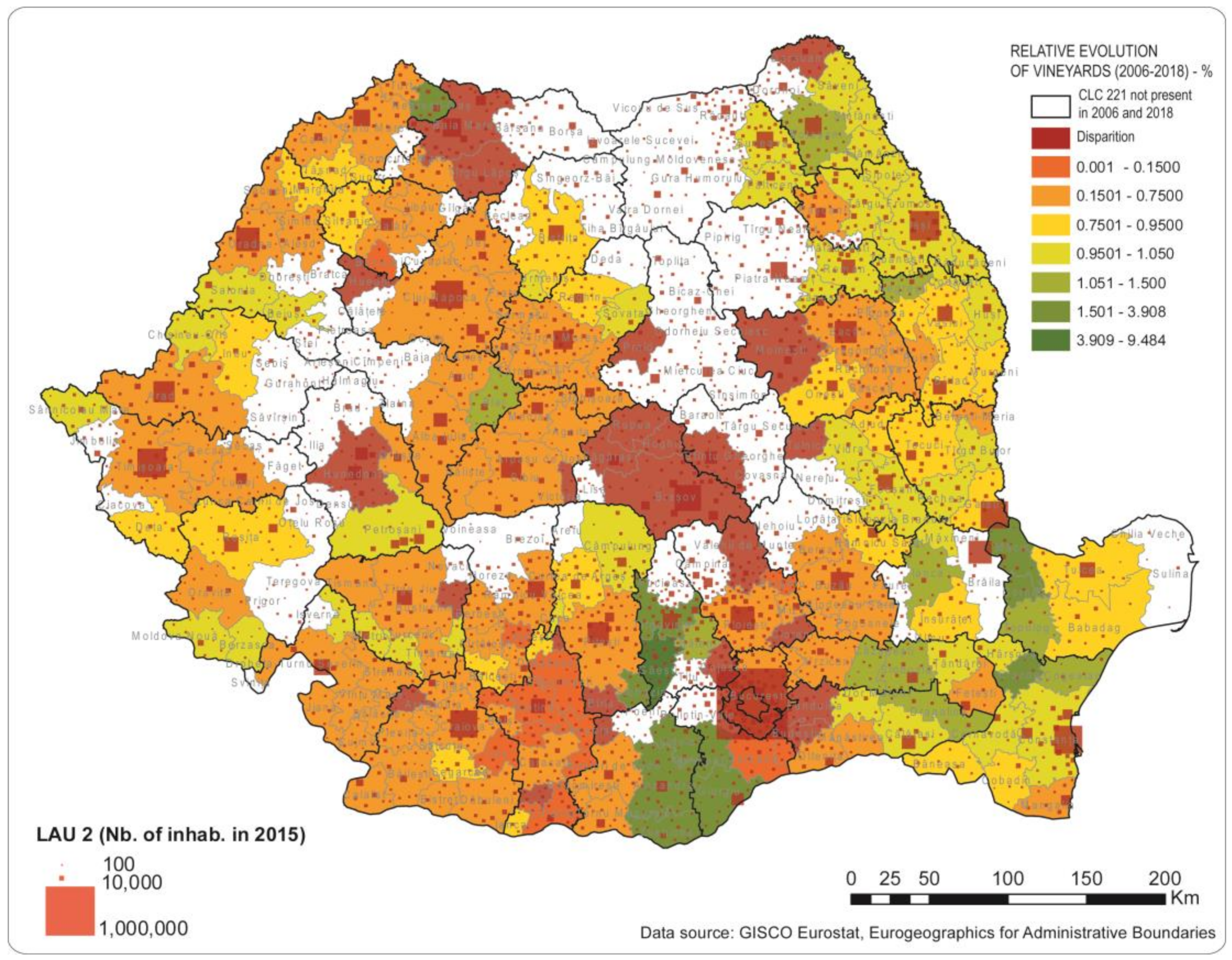
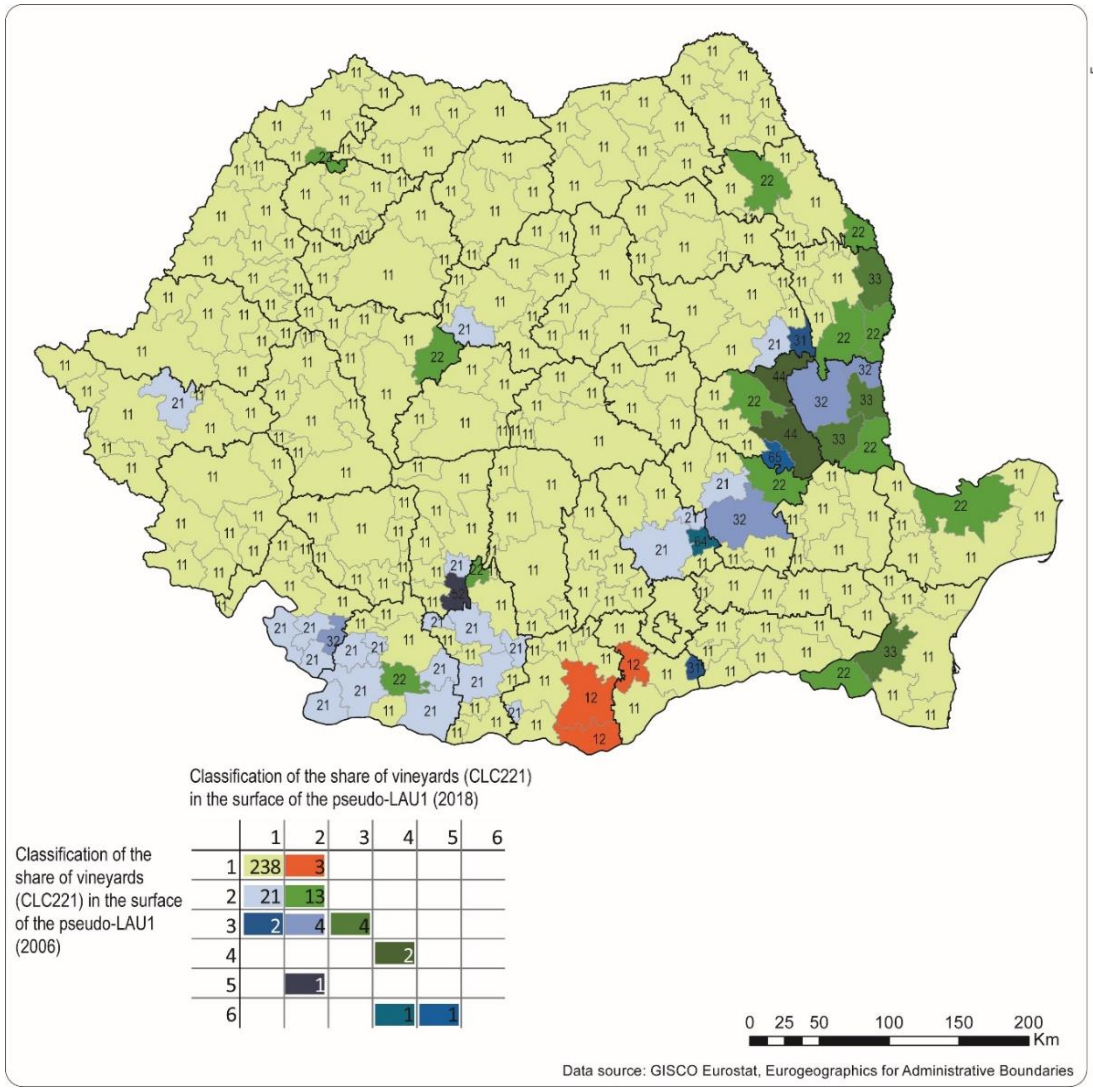
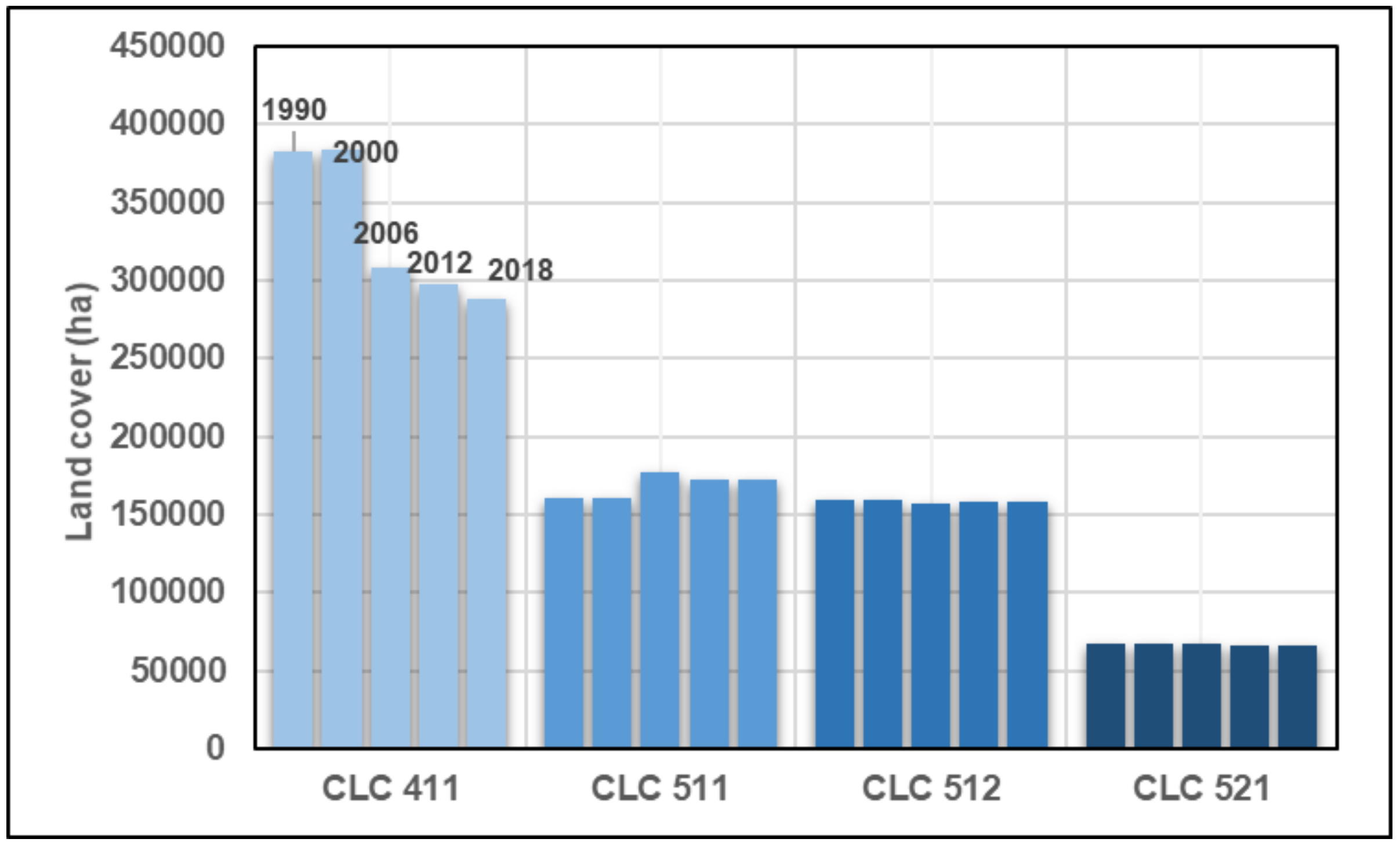
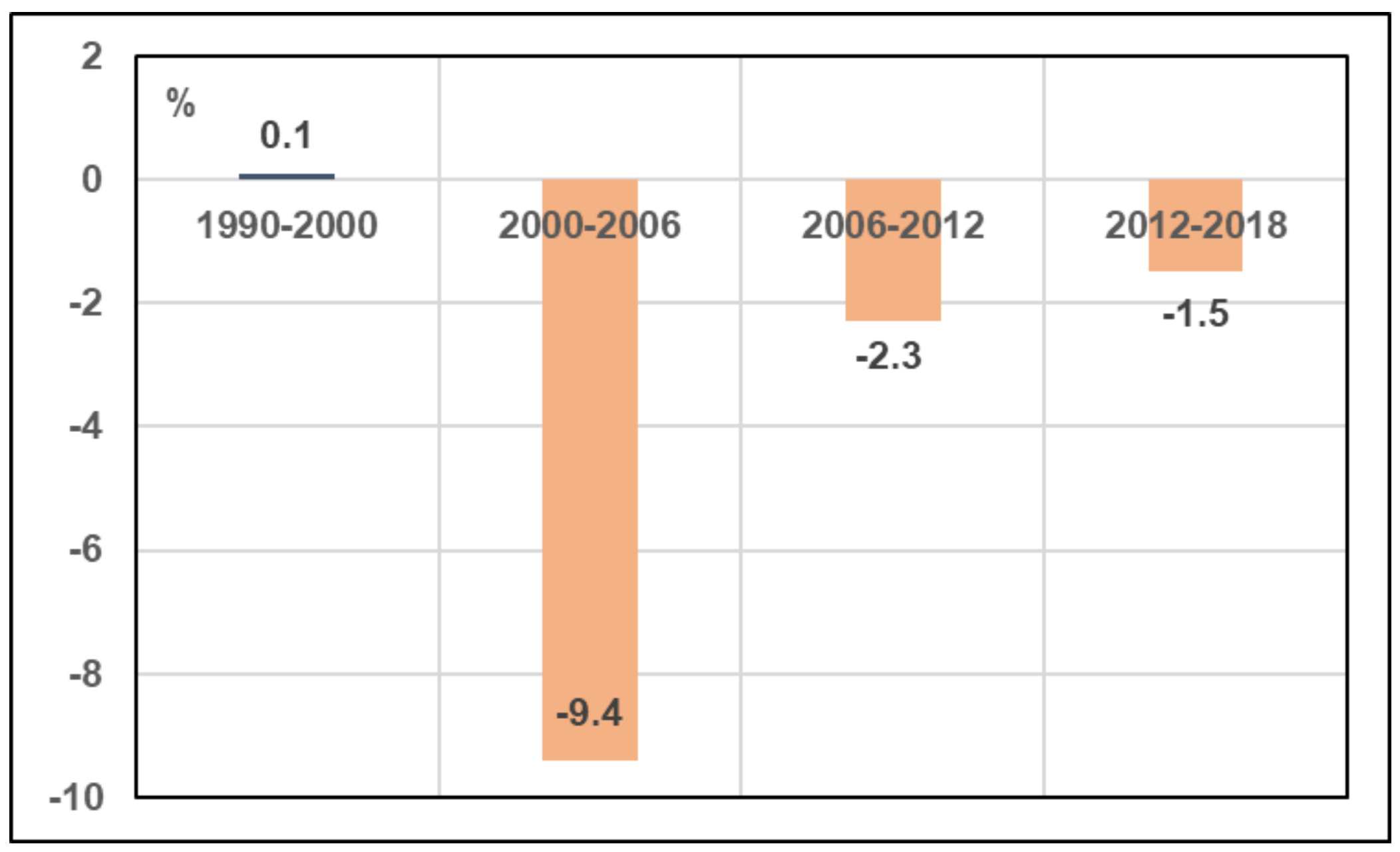
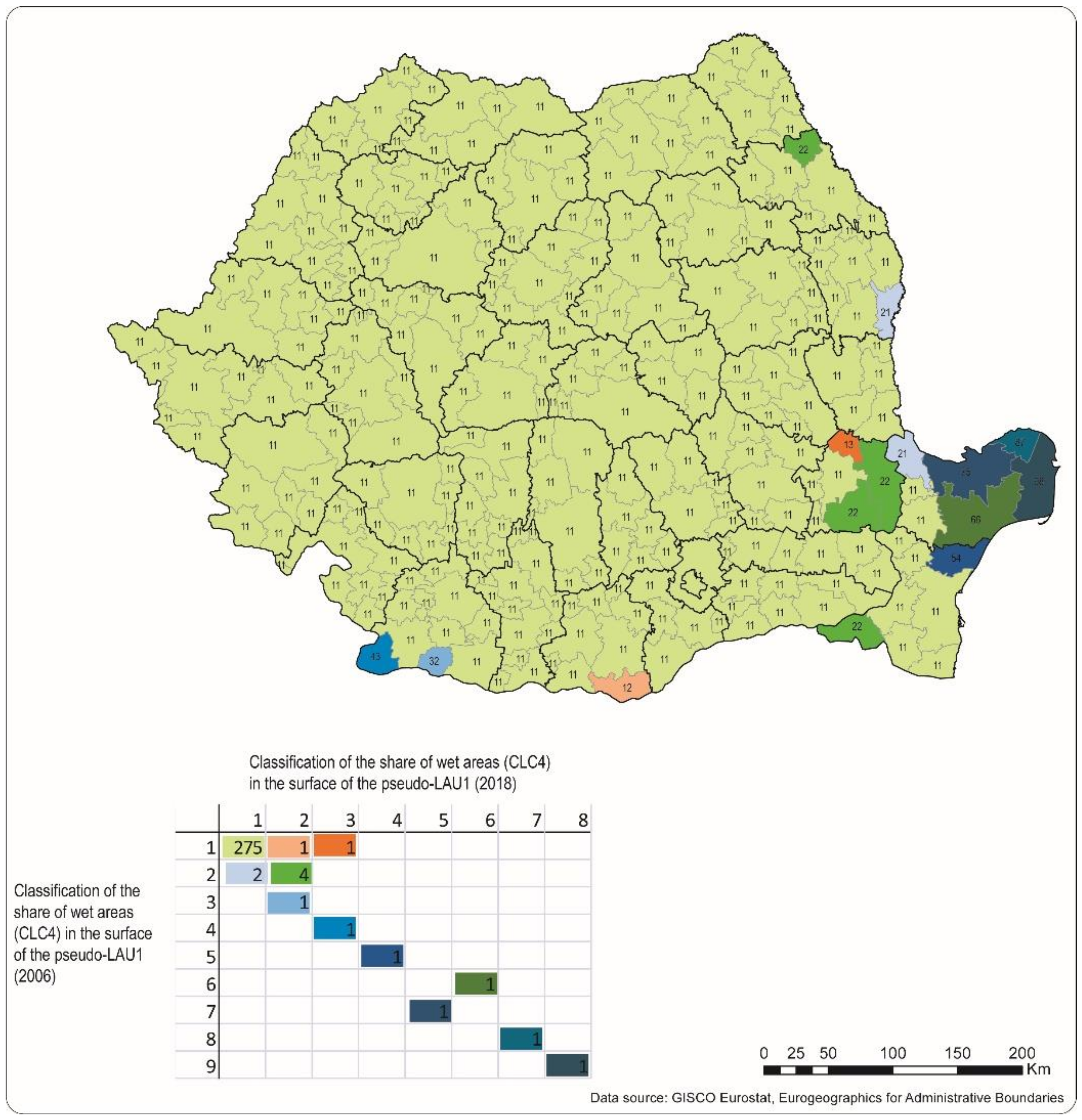

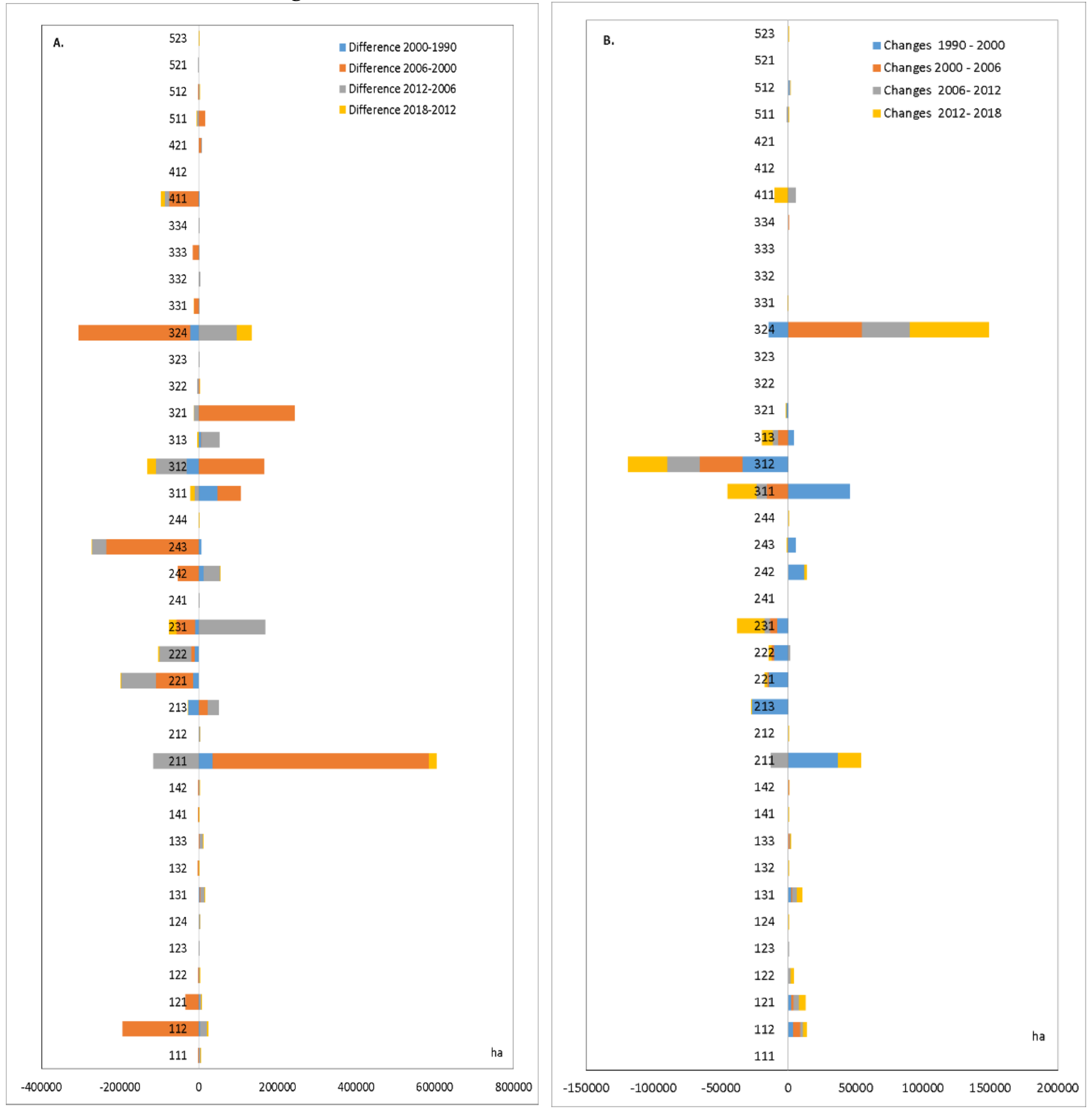

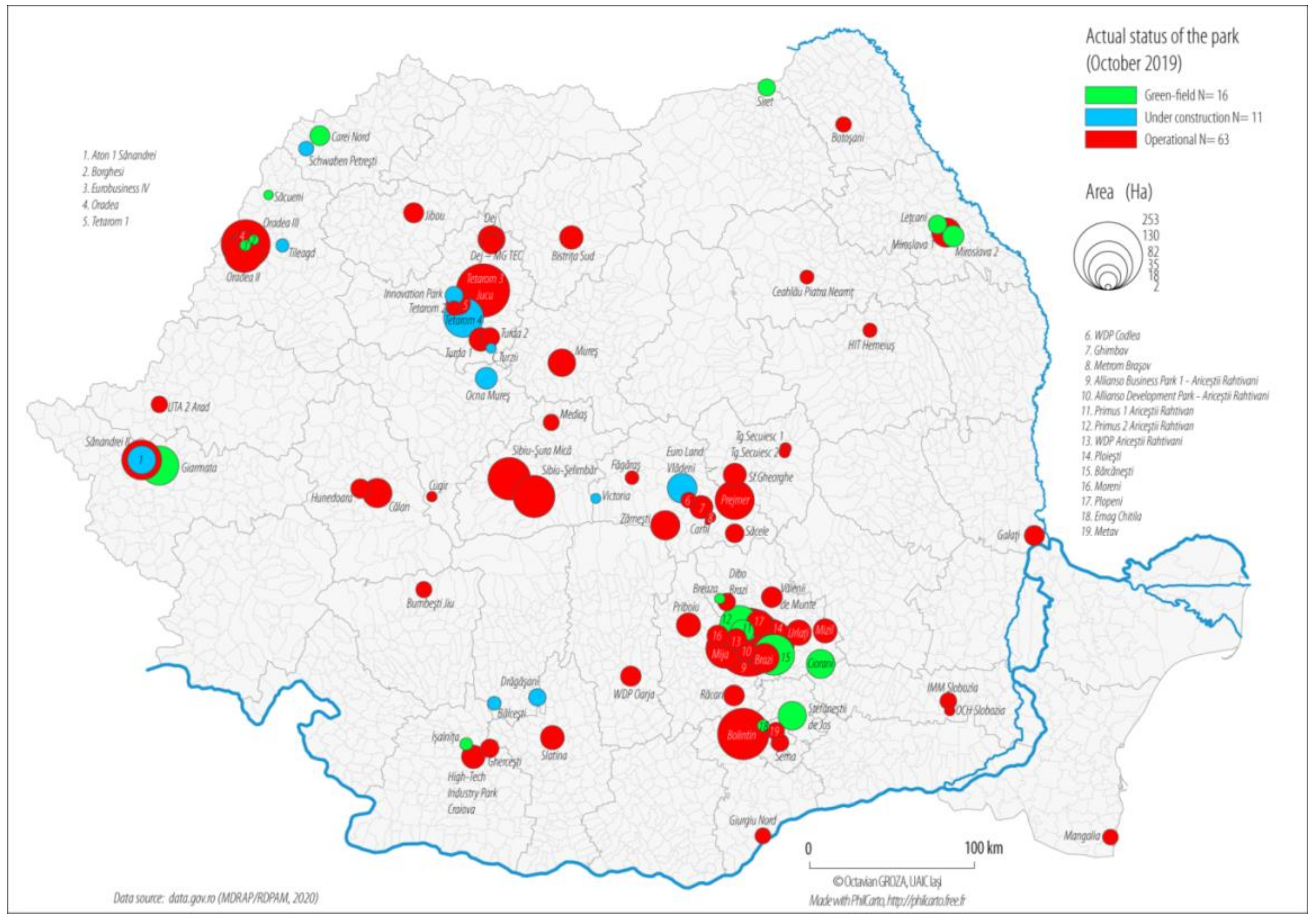
| Share of CLC221 in the Total Surface of Each Pseudo-LAU1 (t1 = 2018) | ||||||||
|---|---|---|---|---|---|---|---|---|
| 0–3% | 3–6% | 6–9% | 9–12% | 12–15% | 15–18% | |||
| Class | 1 | 2 | 3 | 4 | 5 | 6 | ||
| Share of CLC221 in the total surface of each pseudo-LAU1 (t0 = 2006) | 0–3% | 1 | 238 | 3 | ||||
| 3–6% | 2 | 21 | 13 | |||||
| 6–9% | 3 | 2 | 4 | 4 | ||||
| 9–12% | 4 | 2 | ||||||
| 12–15% | 5 | 1 | ||||||
| 15–18% | 6 | 1 | 1 | |||||
| Variable Labels | |||||
|---|---|---|---|---|---|
| CLC Categories | CLC Data for 2006 | CLC Data for 2018 | Pearson r | p-Values | Pearson r Stability Rank |
| CLC31 | FORr06 | FORr18 | 0.998 | <0.0010 | 1 |
| CLC21 | ARBLr06 | ARBLr18 | 0.997 | <0.0005 | 2 |
| CLC4 | WETr06 | WETr18 | 0.994 | <0.0013 | 3 |
| CLC11 | URBr06 | URBr18 | 0.989 | <0.0001 | 4 |
| CLC12 | INDr06 | INDr18 | 0.982 | <0.0002 | 5 |
| CLC32 | SCRUBr06 | SCRUBr18 | 0.947 | <0.0011 | 6 |
| CLC33 | OPENr06 | OPENr18 | 0.934 | <0.0012 | 7 |
| CLC131 | MINEr06 | MINEr18 | 0.930 | <0.0003 | 8 |
| CLC231 | PASTr06 | PASTr18 | 0.927 | <0.0008 | 9 |
| CLC221 | VINEr06 | VINEr18 | 0.872 | <0.0006 | 10 |
| CLC222 | ORCHr06 | ORCHr18 | 0.867 | <0.0007 | 11 |
| CLC24 | AGRHETr06 | AGRHETr18 | 0.847 | <0.0009 | 12 |
| CLC5 | WATr06 | WATr18 | 0.782 | <0.0014 | 13 |
| CLC133 | CONr06 | CONr18 | 0.762 | <0.0004 | 14 |
© 2020 by the authors. Licensee MDPI, Basel, Switzerland. This article is an open access article distributed under the terms and conditions of the Creative Commons Attribution (CC BY) license (http://creativecommons.org/licenses/by/4.0/).
Share and Cite
Rusu, A.; Ursu, A.; Stoleriu, C.C.; Groza, O.; Niacșu, L.; Sfîcă, L.; Minea, I.; Stoleriu, O.M. Structural Changes in the Romanian Economy Reflected through Corine Land Cover Datasets. Remote Sens. 2020, 12, 1323. https://doi.org/10.3390/rs12081323
Rusu A, Ursu A, Stoleriu CC, Groza O, Niacșu L, Sfîcă L, Minea I, Stoleriu OM. Structural Changes in the Romanian Economy Reflected through Corine Land Cover Datasets. Remote Sensing. 2020; 12(8):1323. https://doi.org/10.3390/rs12081323
Chicago/Turabian StyleRusu, Alexandru, Adrian Ursu, Cristian Constantin Stoleriu, Octavian Groza, Lilian Niacșu, Lucian Sfîcă, Ionuț Minea, and Oana Mihaela Stoleriu. 2020. "Structural Changes in the Romanian Economy Reflected through Corine Land Cover Datasets" Remote Sensing 12, no. 8: 1323. https://doi.org/10.3390/rs12081323
APA StyleRusu, A., Ursu, A., Stoleriu, C. C., Groza, O., Niacșu, L., Sfîcă, L., Minea, I., & Stoleriu, O. M. (2020). Structural Changes in the Romanian Economy Reflected through Corine Land Cover Datasets. Remote Sensing, 12(8), 1323. https://doi.org/10.3390/rs12081323







